 |
PO
Box 9021, Wilmington, DE 19809, USA
E-mail: font@focusonnature.com
Phone: Toll-free in USA 1-888-721-3555
or 302/529-1876 |
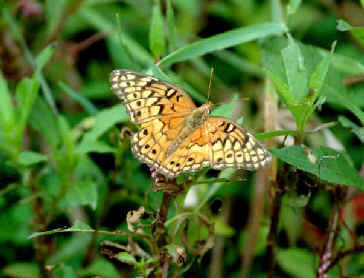 A
List of
A
List of
Chile
Butterflies
and Moths
Noting those during
Focus On Nature Tours
with an (*)
A List of Chilean Butterflies and Moths compiled by Armas Hill
Upper right photo: a Variegated Fritillary,
a species that occurs locally in Chile
Codes relating to illustrations in various
books:
Numbers noted as (BB:xx) refer to pages
in "Butterflies of Buenos Aires (Argentina)", by Gustavo Canals
Numbers noted as (C:xx) refer to pages in
"A World of Butterflies", with text by Brian Cassie, and
photographs (superb) by Kjell Sandved
Numbers noted as (DV:xx) refer to pages
in "Butterflies Of South America", by Bernard D'Abrera
Numbers noted as (F:xx) refer to pages
in "The Illustrated Encyclopedia of Butterflies", by Dr. John
Feltwell
Numbers noted as (MM:xx) refer to pages
in "Mariposas (Butterflies) of Missiones (Argentina)", by
Gustavo Canals
Numbers noted as (S:xx)
refer to pages in the "Smithsonian Handbook, Butterflies
& Moths", by David Carter.
Numbers noted as (WGC:xx) refer to pages in
"A Wildlife Guide to Chile" by Sharon Chester, an excellent
book not just about butterflies and moths but all of the nature of Chile
Links with this List:
PAPILIONIDAE: Swallowtails
PIERIDAE: Whites, Yellows, Marbles
LYCAENIDE: Gossamer Wings
NYMPHALIDAE: Brushfoots HESPERIIDAE: Skippers
Other Links:
Upcoming
FONT Birding & Nature Tours in South America in Chile & Argentina
Lists
& Photo Galleries of Birds,
including those in
South America
Lists
& Photo Galleries of Mammals & Other Wildlife, relating
to South
America
Lists
of Photo Galleries of Amphibians & Reptiles, including
those in
South America
Directory of Photos in this Website

List of Butterflies:
Family PAPILIONIDAE: SWALLOWTAILS (and allies):
Worldwide, there are totally about 700 known species of
SWALLOWTAILS.
Genus BATTUS: PIPEVINE SWALLOWTAILS
- Battus polydamas archidamas ______
(DA:19) (F:38) (MM:140) (S:55) (WGC:93) (subspecies in
Chile)
Polydamas Swallowtail (also called The
Gold Rim, or Black Page) (Note Polydamas was a
Trojan prince.)
CH name: Papilio Negro (and
Aristolochia Swallowtail, referring
to the scientific name of the subspecies)
(Range: throughout the Americas & the Antilles)
In the tropics, Battus polydamas is continuously brooded.
Butterflies live about a week.
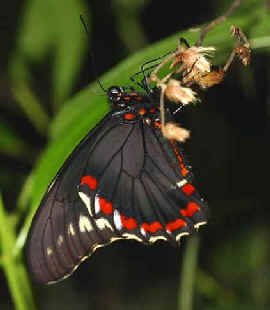
The Polydamas Swallowtail,
the Gold Rim
Family PIERIDAE: most are predominantly white, yellow, or orange in color,
and are often referred to
as WHITES, YELLOWS, SULPHURS, or MARBLES
Worldwide, approximately
1,000 species of whites & sulphurs have been described.
Genus EROESSA: 1 species, confined to low and middle altitudes in Chile only. Considered rare & local.
- Eroessa chilensis ______ (DA:54)
(WGC:97)
Eroessa Butterfly
CH common name: Mariposa eroesa
(Range: Chile, endemic. It occurs locally on the coast from
Maule to Aisen, and in the foothills of Cautin, Osorno, and Llanquihue.)
Eroessa chilensis is greenish-white. The forewings have a conspicuous,
orange transverse band and dark brown wingtips.
The species lives in Nothofagus forest clearings, where it appears in the
spring to feed on red, pink, or white flowers of plants such as the Chilco
(Fuchsia magellanica) and Mora (Rubus sp.).
Genus MATHANIA: 7 species occurring only in temperate
zones or mountainous regions in western South America
The leaf-lie appearance
of the hindwing underside of the species in this genus affords some camouflage
protection.
- Mathania leucothea ______ (WGC:97)
CH common
name: Mariposa del Quintral
(Range: in Chile, from Coquimbo to Valdivia)
Mathania leucothea can be common in gardens especially near
Quintral (Tristerix sp.), an epiphytic plant on which it lays its eggs.
Genus PIERIS
- Pieris brassicae ______
(WGC:97)
Large White
CH common name; Mariposa
Blanca de la Col
(Range: in Chile, from Coquimbo to
Valdivia, in vegetable gardens, along roadsides, and in towns)
Pieris brassicae is an
introduced species in Chile, where it can be an agricultural pest. It is
native to Eurasia.
Genus TATOCHILA: About 15 species endemic to the
southern part of South America, from approximately southern Brazil to Tierra
del Fuego; and at moderate to high altitudes from Venezuela to Peru.
- Tatochila theodice
______ (WGC:97)
Andean Foothills White
CH common name: Mariposa Blanca Preandina
(Range: in Chile, from Arica to Valdivia)
- Tatochila mercedes (*)
______ (WGC:97)
Common White Tatochila
CH common name: Mariposa Mercedes
(Range: in Chile, from Arica to Magallanes)
Genus HYPSOCHILA: 6 species are in this genus similar
to TATOCHILA, differentiated by their smaller size and generally more grayish
ground color in both sexes. From Peru to Tierra del Fuego.
-
Hypsochila wagenknecti ______
CH common name: Mariposa de Wagenknect
(Range: in Chile, from Coquimbo to Santiago, where
it is common in foothill areas)
-
Hypsochila argyrodice ______
Pampas White
CH common name: Mariposa
Blanca de la Estepa
(Range: in Chile, on the Patagonian
steppe, where it is uncommon)
Genus PHULIA: A group of from 3 to 12 species. Their most outstanding
characteristic is that they occur at South American high elevations, up to
16,000 ft. (5,000 meters) above sea level. So, observing these little
butterflies in the wild would be beyond the capacity of most.
- Phula nimphula nympha ______
(DA:70)
CH common
name: Mariposa Blanca Andina
(Range: central Chile, Argentina, Bolivia -
at very high altitudes; in Chile, common in the Andes from Arica to Santiago)
Genus INTRAPHULIA
- Intraphulia ilyodes ______
CH common name: Fulia de
Pantano
(Range: In Chile, in high Andean
bofedales and marshes from Arica to Antofagasta)
Subfamily COLIADINAE: SULPHURS
300 species worldwide
Genus COLIAS: SULPHURS: This genus in South America tends to occupy
temperate and/or high altitude habitats. Essentially, this genus, of 10
species, is Holarctic (North American/Eurasian).
- Colias
(or
Zerene) cesonia ______
(C:249) (F:109) (WGC:93)
(Southern) Dogface
CH common name: Mariposa amarilla boliviana
(Range: Mexico to Argentina; in Chile in the valleys of Arica
& Tarapaca)
The Dogface, or Colias cesonia, is common, particularly so where there is cattle ranching. The leguminous plants
on which it breeds are used for cattle.
Overall, Colias cesonia is lemon-colored. It has broad, irregular black
margins on the forewings that suggest a dog's face in
silhouette.
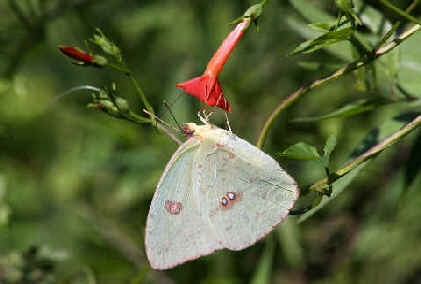
Southern Dogface
(photo by Doris Potter)
- Colias lesbia ______
Colias lesbia andina ______ (DA:56)
Lucen's Butterfly
CH common name: Colias Argentina
(Range: Bolivia to Tierra del Fuego; in Chile in Nuble, Malleco,
and Magallanes)
Colias lesbia is sexually dimorphic. The wings of the male
are orange with black margins. Those of the female are gray with darker gray
spots.
- Colias vauthierii ______
(WGC:93)
CH common name: Colias de la Alfalfa
(Range: in Chile, from Atacama to
Chiloe)
Colias vauthierii is sexually
dimorphic. The wings of the male are orange with black margins. Those of the
female are gray with black or dark patches.
Colias vauthierii is found in
alfalfa fields, as is the previous species, Colias lesbia.
- Colias flaveola ______
CH common name: Colias de
Blanchard
(Range: in high Andean valleys in
Argentina & Chile, where it is a common species)
Colias flaveola is a pale
grayish-green. Males have an orange spot on the hindwing.
- Colias mendozina ______
CH common name: Colias de
Mendoza
(Range: Primarily an Argentine
species. In Chile, rare on hillsides and quebredas of the Aconcagua Valley
near Portillo)
Colias mendozina is a pale gray.
Genus PHOEBIS: GIANT SULPHURS: the most
conspicuous tropical sulphurs, common, and found in open areas &
forest edges, adult males cluster on moist sand along rivers & streams
-
Phoebis sennae amphitrite (*) ______ (C:247)
(DA:57) (F:105) (WGC:93)
Cloudless Sulphur
CH common name: Mariposa Limonera
(Range: southern US to Argentina,
also in Antilles. In Chile, from Atacama to Valdivia)
Phoebis sennae can be abundant in both lowlands & highlands. It prospers in open
land.

Cloudless Sulphur
Genus EUREMA: SMALL YELLOWS
-
Eurema (or
Terias)
deva chilensis ______ (WGC:93)
CH common name: Mariposa Amarilla
(Range: in central Chile, from Copiapo to Aconcagua)
The larvae of Eurema deva feed (in Chile) on the mimosa tree, Cassia
stipulacea,
In central Chile, where the butterfly is very common, it occurs in scrub on
Andean slopes up to around 5,500 feet above sea level. The butterfly is a slow
flier.
Family LYCAENIDAE (GOSSAMER WINGS): including: HAIRSTREAKS,
BLUES
Throughout the world but mostly in tropical and subtropical regions.
The sexes often differ in coloration, and the undersides usually differ from the
upper surfaces.
Among several distinct groups are the HAIRSTREAKS,
with tails and bright eyespot markings on the hindwings, creating a "false
head" at the rear, to divert attackers.
Thus far, worldwide, about 5,000 species in this family have been discovered and
named.
Caterpillars of many of these species are closely associated with ants.
Genus MINISTRYMON: HAIRSTREAKS of
North & South America that have adaptations for living in deserts. Breed on
mesquites, spiny trees, and shrubs of the Proposis genus, which grow in deserts,
especially by watercourses. The colors of the butterflies are blue, gray, and
black.
- Ministrymon azia ______
(WGC:97)
Gray Ministreak (or
Azia Hairstreak)
CH common name: Licena Invasora
(Range: south Texas to southern Brazil, also West Indies. In Chile,
from Arica to Atacama)
Ministrymon azia lives in arid places. It favors thorn scrub and
matorral.
- Ministrymon quebradivaga ______
(WGC:97)
CH common
name: Licena de la Quebrada
(Range: in Chile, in the valleys of Arica and Tarapaca)
Ministrymon quebradivaga flies above treetops.
Genus EISELIANA
- Eiseliana bicolor ______
(WGC:97)
Bicolored Hairstreak
CH common name: Licena de
Dos Colores
(Range: in Chile, from Atacama to
Biobio, where it is common near flowers and flowering shrubs)
Genus HEODA
- Heoda wagenknecti ______
CH common name: Licena de
Wagenknect
(Range: in Chile, from Atacama to
Coquimbo, in a variety of habitats)
Heoda wagenkncecti is gray
with a large spot of orange on the wings.
- Heoda nivea ______
CH common name: Licena
Nevada
(Range: in Chile, from Coquimbo to
Aisen, in Andean foothills)
Heoda nivea is brown.
Genus STRYMON: SCRUB HAIRSTREAKS: In both
North & South America. Butterflies exhibit seasonal variation.
- Strymon eurytulus ______
(MM:210) (WGC:97)
Scrub Hairstreak
CH common name: Licena Tornasol Comun
(Range: in Chile, from Atacama to Chiloe, in woodlands,
fields, and gardens)
- Strymon crambusa ______
CH common name: Licena de Atacama
(Range: in Chile, along the Atacama coast near Caldera, where
it is rare)
Subfamily POLYOMMATINAE: BLUES
Very small butterflies, mostly blue above. Females of many are browner.
Genus ITYLOS
- Itylos titicaca ______
(WGC:97)
Dwarf Blue
CH common name:
Licena enana
(Range: in Chile, from Arica to
Antofagasta; also in Peru & Bolivia)
Itylos titicaca is found in
Astagalus milk vetch on the puna steppe, and in bofedales and Polylepis
groves above 10,000 feet.
Genus LEPTOTES
- Leptotes trigemmatus ______
(WGC:97)
Tamarugo
Blue
CH common name: Licena del Tamarugo
(Range: in Chile, from Arica to Santiago)
The larvae of Leptotes trigemmatus live in association
with ants. The larvae feed on buds, flowers, and leaves, of Prosopis
tamarugo, a tree cultivated for fodder in the Atacama Desert. These larvae
are a major food source for the bird known as the Tamarugo Conebill.
Genus PSEUOLUCIA: There are 21
species in this genus in Chile. They come in a broad range of colors,
ranging from blue to brown to silver, often with orange, white, or brown
patterns and an overlay of blue to silver iridescence.
Females and males differ in color or markings in most species.
- Pseuolucia chilensis ______
(WGC:97)
Chilean Blue
CH common name: Licena
Morena
(Range: in Chile, from Atacama to
Santiago)
- Pseuolucia collina ______
CH common name: Licena
Celeste
(Range: in Chile, from Coquimbo to
Nuble)
Pseudolucia collina
butterflies are often seen resting on the ground, or flying around flowers
and shrubs in open areas in the foothills.
- Pseudolucia lyrnessa ______
CH common name: Licena Confusa
(Range: in Chile, from Coquimbo to Biobio)
- Pseudolucia aureliana ______
Aurelian Blue
(Range: in Chile, in the Atacama Mountains)
Both males and females of the Aurelian Blue are a deep lustrous
blue with checkered fringes.
The species is named for "the Aurelian", a short story in
which Pilgrim, an ardent butterfly collector, is unable to fulfill his dream
of journeying to the tropics.
- Pseudolucia charlotte ______
Charlotte's Blue
(Range: in Patagonian areas of Argentina & Chile)
Pseudolucia charlotte is named for Lolita's mother, Charlotte.
- Pseudolucia hazeorum ______
CH common name: Licena de los Haze
(Range: in Chile, in the Andes above 6,500 feet above sea
level)
- Pseudolucia whitakeri ______
Whitaker's Blue
(Range: in Chile and Argentina in Patagonia)
- Pseudolucia zembla ______
Zembla Blue
(Range: in Chile, in the Andes)
Family NYMPHALIDAE: BRUSHFOOTS
Cosmopolitan, with
subfamilies range from 8 to 25, depending upon taxonomic treatment.
This is the most diverse family of butterflies, with approximately 6,000
known species worldwide.
Brushfoot butterflies appear 4 rather than 6-legged as their 2 front legs
are much reduced.
Subfamily LIBYTHEINAE:
SNOUTS
Genus LIBYTHEANA: SNOUTS
- Libytheana carinenta ______
(C:281) (F:175) (MM:255) (S:146) (WGC:101)
American Snout (or Snout
Butterfly)
CH common name: Mariposa Comun del Tropico
(Range: southern US to Argentina. In Chile, locally in coastal Linares)
Genus VANESSA: LADY
BUTTERFLIES
- Vanessa carye (*) ______
(MM:321) (WGC:101)
Four-eyed Lady
CH common name: Mariposa Colorada
(Range: widespread in South America in a variety of habitats,
including towns and cities. In Chile, Arica to Magallanes)
Vanessa carye is a smaller sister species of the Painted Lady,
Vanessa cardui.
The larvae feeds on nettles and mallows.
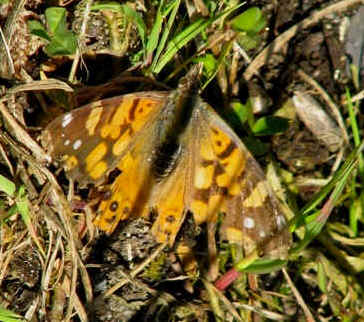
A Four-eyed Lady photographed on Chiloe Island
during the FONT Chile Tour in November 2011
(photo by Frank Stermitz)
- Vanessa terpsichore ______
CH common name: Mariposa Colorada de Philippi
(Range: in Chile, occurs commonly from Coquimbo to Magallanes)
Vanessa terpsichore is very similar to Vanessa carye, but it is
paler.
Genus DIONE
- Dione glycera ______
(WGC:101)
Andean Silverspot
CH common name: Mariposa Dione
(Range: in Chile, in Arica and Tarapaca, where it occurs in open and
deforested areas, villages and towns, and in mid-elevation valleys)
Genus YRAMEA
- Yramea cytheris ______ (WGC:101)
Cyntheris Fritillary
CH common name: Mariposa Pintada Comun
(Range: in Chile, from Santiago to Magallanes)
Yramea cytheris
is often seen resting on the ground.
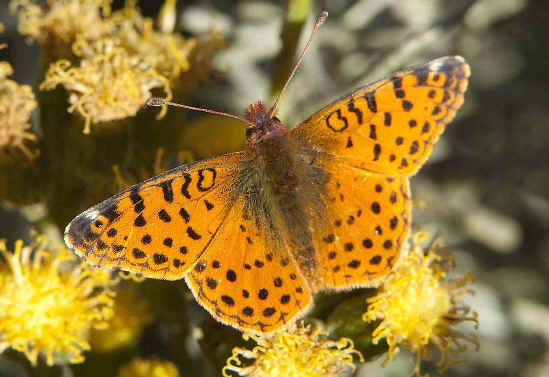
A Cyntheris Fritillary at Torres del Paine Park
in southern Chile
(photo courtesy of Jim Zuckerman)
- Yramea lathonioides ______
CH common name: Mariposa Pintada de la Altura
(Range: in Chile, from Atacama to Magallanes, in foothills and mountains)
- Yramea modesta ______
CH common name: Mariposita Pintada Chica
(Range: in Chile, from Coquimbo to Llanquihue, where it is uncommon in the
high Andes)
Genus EUPTOIETA
-
Euptoieta claudia hortensia ______
(MM:338) (WGC:101)
Variegated Fritillary
CH common name: Mariposa Hortensia
(Range: Canada thru Central & South America, also the West Indies. In
Chile, from Coquimbo to Valdivia)
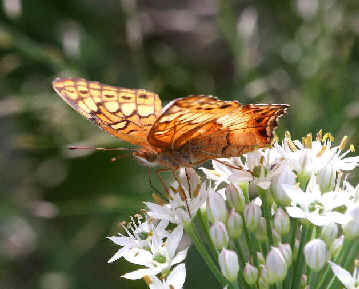
Variegated Fritillary
(photo by Doris Potter)
Genus DANAUS:
ROYALTY, MILKWEED BUTTERFLIES
- Danaus plexippus erippus ______
(C:37) (F:143) (S:184) (WGC:97)
CH common name: Monarcha
Monarch
(Range: a truly cosmopolitan species, occurring in North &
south America, Australia, and the East Indies)
Danaus plexippus is a very strong flier with strong migratory
tendencies in temperate regions, but not in the tropics or elsewhere in
South America, such as Chile, where it is usually a solitary flier and does
not migrate.
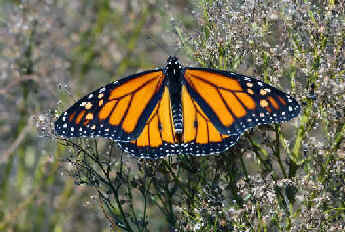
Monarch
(photo by Howard Eskin)
Subfamily SATYRINAE: SATYRS
Most SATYRS are drab colored. The butterflies are brown or gray and
have eyespots (ocelli) on both the upper and lower faces of the wings. Their
flight is fast and erratic, and they are most often seen at dawn and
dusk.
The butterflies feed on flower nectar.
SATYRS produce only one brood annually, and they overwinter as
larvae.
- Argyrophorus argenteus ______
(WGC:101)
Silver Satyr
CH common name: Mariposa Plateada
(Range: in Chile, from Coquimbo to Aisen, in a wide variety of
habitats.
Argyrophorus argenteus
has a very fast flight.
- Argyrophorus penai ______
(Range: in Chile, a rare resident in the mountains of Antofagasta)
- Cosmosatyrus chilensis ______
(WGC:101)
Common Chilean Satyr
CH common name: Satirido Negro Comun
(Range: in Chile, from Atacama to Magellanes)
Cosmosatyrus chilensis
is one of the most common butterflies in Chile.
- Cosmosatyrus leptoneuroides
______
CH common name: Mariposa del Coiron
(Range: in Chile, from Coquimbo to Magallanes, where it inhabits high
altitude grasslands)
- Fanula leocognele ______
CH common name: Satirido de Ocelo Blanco
(Range: in Chile, from Tarapaca to Nuble, in the High Andes)
- Fanula patagonia ______
CH common name: Satirido de la Estepa Patagonica
(Range: in Chile, in Aisen on steppes)
- Chillanella (or Tetraphlebia) stelligera
______
Starry Satyr
CH common name: Satirido Estrellado
(Range: in Chile, from Coquimbo to Valdivia)
- Tetraphlebia germaini ______
(WGC:100)
CH common name: Satirido de Franja Gris
(Range: in Chile, from Santiago to Nuble, in foothills and high
mountains)
- Neosatyrus ambriorix ______
Ochre-banded Satyr
CH common name: Satirido de Banda Ocre
(Range: in Chile, from Valparaiso to Valdivia)
- Neomaenas janiriodes ______
(WGC:101)
Janiriodes Satyr
CH common name: Satirido Confuso
(Range: from Coquimbo to Valdivia, where it is common in a variety of
habitats)
- Neomaenas monarchus ______
(WGC:101)
Monachus Satyr
CH common name: Satirido Monacal
(Range: from Coquimbo to Aisen)
- Neomaenas fractifascia ______
CH common name: Satirido Rojizo
(Range: from Nuble to Valdivia, in places with bamboo
thickets; it can be common)
- Auca pales ______ (WGC:101)
Pale Satyr
CH common name: Satirido Palido
(Range: from Santiago in Chile to southern Argentina; can be
common)
- Auca coctei ______
Coctei Satyr
CH common name: Satirido Coctel
(Range: in Chile, from Coquimbo to Aisen)
- Elina montroli ______ (WGC:102)
Matorral Satyr
CH common name: Satirido Grande del Matorral
(Range: in Chile, from Valparaiso to Valdivia, in matorral)
- Elina vanessoides ______ (WGC:102)
CH common name: Satirido Danzarino
(Range: in Chile, from Concepcion to Isla Chiloe, in
Nothofagus forest)
- Nelia nemyroides ______
CH common name: Satirido del Sotobosque
(Range: in Chile, from Cachapoal to Llanquihue, in Chusquea
bamboo understory, where it can common)
Family HESPERIIDAE: SKIPPERS
A very large family (3,000 species throughout the world) of stout-bodied
short-winged butterflies that resemble day-flying moths. The adult
butterfly's flight resembles a 'skipping' motion when going from flower to
flower. Their forewings are closed above their back when they are settled.
Genus URBANUS: LONG-TAILED SKIPPERS
- Urbanus proteus proteus ______
(BB:53) (MM:49) (S:36) (WGC:93)
(Common) Long-tailed Skipper
CH common name: Hesperia de Proteo
(Range: south Texas to Argentina, also Florida & West Indies. In
Chile, in the Azapa and Lluta Valleys in Arica, and in other similar habitats
in northern Chile)
- Urbanus dorantes ______
(BB:55) (MM:51)
Dorantes Longtail (or
Skipper)
CH common name: Hesperia Dorantes
(Range: south Texas to Argentina, also in Florida & the West
Indies. In Chile, in the Azapa Valley, Arica)
- Butleria flavomaculata
______ (WGC:93)
Spot-winged Skipperling
CH common name: Hesperia
de Alas Manchadas
(Range: Chile, endemic; common
from Coquimbo to Aisen)
- Butleria fruticolens patagonica
______
CH common name: Hesperia
Manchada
(Range: in southern Chile, it is
common)
- Butleria paniscoides ______
Chilean Skipperling
CH common name: Hesperia
Chilena
(Range: in Chile, from Coquimbo to
Aisen, where common)
- Butleria elwesi ______
CH common name: Hesperia
de Elwes
(Range: in Chile, from Aconcagua
to Chiloe, in bamboo thickets)
- Butleria philippi ______
CH common name: Hesperia
de Philippi
(Range: in Chile, from Nuble to
Osorno, in bamboo thickets, uncommon)
- Argopteron aureipennis ______
Gold-winged Skipper
CH common name: Lluvia de
Oro
(Range: in Chile, from Biobio to
Valdivia in bamboo thickets; it can be common)
- Argopteron puelmae ______
CH common name: Hesperia
de Puelma
(Range: in Chile, from Maule to
Aisen in Nothofagus forest, where red, pink, or white flowers are present;
it can be common)
- Argopteron aureum ______
CH common name: Hesperia
Dorada
(Range: in Chile, in Linares)
Argopteron aureum is a rare
species that is found in bamboo thickets in the Cordillera de Parral.
Genus ERYNNIS: TRUE DUSKY WINGS
- Erynnis funeralis ______
(BB:83) (MM:94) (WGC:93)
Funereal Dusky Wing
CH common name: Hesperia Negra
(Range: southwest US to Argentina. In Chile, from Atacama to
Araucania)
Genus PYRGUS: CHECKERED SKIPPERS (or GRIZZLED SKIPPERS)
Species in Chile are dusky brown with pale
squared spots. The larvae feed on mallows.
- Pyrgus barrosi ______
CH common name: Hesperia de Octavio
(Range: in Chile, in Antofagasta at sandy sites with leguminous
vegetation, at around 13,000 feet above sea level)
- Pyrgus bocchoris ______
(WGC:93)
Grizzled Skipper
CH common name: Hesperia de Tres Manchas
(Range: in Chile, commonly from Arica to Biobio)
- Pyrgus fides ______
CH common name: Hesperia Parda
(Range: in Chile, fairly common from Arica to central Chile)
- Pyrgus notatus ______
CH common name: Hesperia Parda Comun
(Range: in Chile, fairly common from Santiago to Valdivia)
Genus HELIOPYRGUS
- Heliopyrgus (formerly Pyrgus)
americanus bellatrix ______ (BB:87)
(MM:95)
CH common name: Hesperia Gris Comun
(Range: in Chile, from Atacama to Biobio)
The flight of Heliopyrgus americanus in Chile is from September
to May.
Genus HYLEPHILA: BRANDED SKIPPERS
- Hylephila fasciolata ______
CH common name: Hesperia del Pasto
(Range: in Chile, from Atacama to Magallanes)
- Hylephila signata ______
CH common name: Hesperia Amarilla Comun
(Range: in Chile, from Atacama to Magallanes)
- Hylephila venusta ______
CH common name: Hesperia Elegante
(Range: in Chile, from Nuble to Aisen)
Genus LERODEA
- Lerodea eufala ______
Eufala Skipper
CH common name: Hesperia Eufala
(Range: southern US to southern Argentina, also Cuba. In
Chile, from Atacama to Valdivia)
Eufala Skippers feed on nectar from flowering alfalfa and
daisies. They occur in open, sunny areas in vacant lots, agricultural
fields, road edges, and lawns.
To Top
of Page


 A
List of
A
List of





